Borage
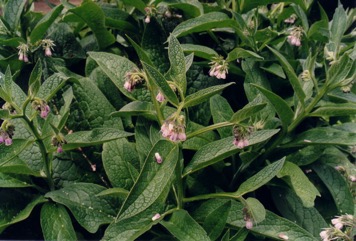
They can grow in full sun or light shade. They do best in a fairly rich, moist, well drained soil. In the tropics it can be grown in mountain regions. In Hobart Botanical gardens. It suits hardiness zones 5-10.
Also known as:
Bee bread, Boragine, Boretse, Boratsino, Borraga, Borrainas, Borraja, Bou cassal, Bou chenaf, Boukhrich, Bou krich, Bourrache, Bugloss, Burraccelle, Buragine, Cool-tankard, Foudelggem, Gabbuina, Harcha, Iles ouaral, Ligabuinna, Star Flower, Talewort, Tament, Tizizoua, Vurraine, Zdravilna boraga
Edible Portion
- Leaves, Herb, Spice, Flowers, Vegetable
Where does Borage grow?
Found in: Africa, Argentina, Asia, Australia, Brazil, Britain, Canada, Chile, China, Condo DR, Croatia, Cyprus, Czech Republic, East Africa, Europe, France, Germany, Greece, India, Indonesia, Iran, Italy, Lebanon, Libya, Macedonia, Mediterranean, Morocco, New Zealand, North Africa, North America, Pacific, Philippines, Portugal, SE Asia, Serbia, Sicily, Slovenia, South Africa, Southern Africa, South America, Spain, Switzerland, Syria, Tasmania, Tunisia, Turkey, Uruguay, United States, Zimbabwe
Notes: There are 3 Borago species.
Status: It is a commercially cultivated vegetable.
Growing Borage
Cultivation: It is grown from seed. Seed are sown 12 mm deep. The taproot is easily damaged in transplanting. Plants drop seed easily and become self sown.
Edible Uses: The flowers and leaves are used to flavour liqueurs and summer drinks. The flowers are also sucked. The young leaves can be used in salads. They have a cucumber like flavour. They are also fried in batter. They are also stuffed like grape leaves. The older leaves are boiled and used in soups. They are also added to omelettes. They are used in pickles. CAUTION: It may not be wise to eat large amounts over a long time due to Pyrrolizidine alkaloids.
Production: It grows quickly. The leaves are normally used fresh. They can be used dried but must be dried quickly in a dry well ventilated place.
Nutrition Info
per 100g edible portion| Edible Part | Energy (kcal) | Protein (g) | Iron (mg) | Vitamin A (ug) | Vitamin c (mg) | Zinc (mg) | % Water |
|---|---|---|---|---|---|---|---|
| Leaves - raw | 21 | 1.8 | 3.3 | 420 | 35 | 0.2 | 93 |
| Leaves - cooked | 25 | 2.1 | 3.6 | 438 | 32.5 | 0.2 | 92 |
| Flowers | - | - | - | - | - | - |
Borage Photos

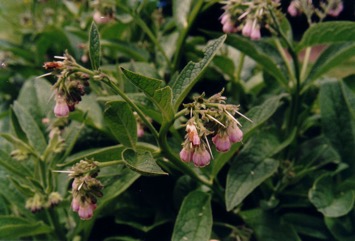
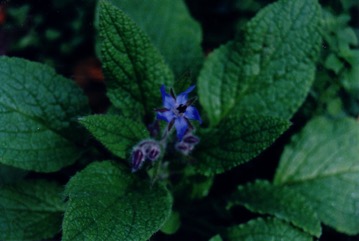
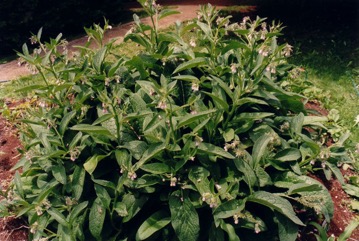
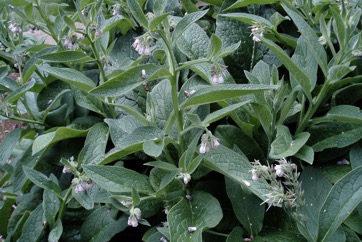
References
Abbet, C., et al, 2014, Ethnobotanical survey on wild alpine food plants in Lower and Central Valais (Switzerland). Journal of Ethnopharmacology 151 (2014) 624–634
Ambasta, S.P. (Ed.), 2000, The Useful Plants of India. CSIR India. p 77
Ben Ismail, H., 2013, Edible Wild Vegetables Used in North West of Tunisia. PARIPEX - Indian Journal of Reearch 2(9) :219-221
Bianchini, F., Corbetta, F., and Pistoia, M., 1975, Fruits of the Earth. Cassell. p 58
Bircher, A. G. & Bircher, W. H., 2000, Encyclopedia of Fruit Trees and Edible Flowering Plants in Egypt and the Subtropics. AUC Press. p 61
Biscotti, N. & Pieroni, A., 2015, The hidden Mediterranean diet: wild vegetables traditionally gathered and consumed in the Gargano area, Apulia, SE Italy. Acta Societatis Botanicorum Poloniae 84 (3): 327-338
Biscotti, N. et al, 2018, The traditional food use of wild vegetables in Apulia (Italy) in the light of Italian ethnobotanical literature. Italian Botanist 5:1-24
Blamey, M and Grey-Wilson, C., 2005, Wild flowers of the Mediterranean. A & C Black London. p 191
Blanco-Salas, J., et al, 2019, Wild Plants Potentially Used in Human Food in the Protected Area “Sierra Grande de Hornachos” of Extremadura (Spain). Sustainability 2019, 11, 456
Bodkin, F., 1991, Encyclopedia Botanica. Cornstalk publishing, p 154
Bonet, M. A. & Valles, J., 2002, Use of non-crop food vascular plants in Montseny biosphere reserve (Catalonia, Iberian Peninsula). International Journal of Food Sciences and Nutrition (2002) 53, 225–248
BOUQUET,
Bremness, L., 1994, Herbs. Collins Eyewitness Handbooks. Harper Collins. p 233
Brickell, C. (Ed.), 1999, The Royal Horticultural Society A-Z Encyclopedia of Garden Plants. Convent Garden Books. p 183
Brown, D., 2002, The Royal Horticultural Society encyclopedia of Herbs and their uses. DK Books. p 145
Burnie, G & Fenton-Smith, J., 1999, A Grower's Guide to Herbs. Murdoch Books. p 17
Burnie, G. (Ed.), 2003, Annuals and Bulbs. The Gardener's Handbooks. Fog City Press. p 126
Cheifetz, A., (ed), 1999, 500 popular vegetables, herbs, fruits and nuts for Australian Gardeners. Random House p 118
Cordero, S. E., Abello, L. A., & Galvez, F. L., 2017, Plantas silvestres comestibles y medicinales de Chile y otras partes del mundo. CORMA p 150
Cundall, P., (ed.), 2004, Gardening Australia: flora: the gardener's bible. ABC Books. p 242
Curtis, W.M., 1993, The Student's Flora of Tasmania. Part 3 St David's Park Publishing, Tasmania, p 490
Della, A., et al, 2006, An ethnobotanical survey of wild edible plants of Paphos and Larnaca countryside of Cyprus. J. Ethnobiol. Ethnomed. 2:34
Ertug, F, Yenen Bitkiler. Resimli Türkiye Florası -I- Flora of Turkey - Ethnobotany supplement
Esperanca, M. J., 1988. Surviving in the wild. A glance at the wild plants and their uses. Vol. 1. p 134
Facciola, S., 1998, Cornucopia 2: a Source Book of Edible Plants. Kampong Publications, p 51
Gonzalez, J. A., et al, 2011, The consumption of wild and semi-domesticated edible plants in the Arribes del Duero (Salamanca-Zamora, Spain): an analysis of traditional knowledge. Genetic. Resour Crop Evolution 58:991-1006
Hadfield, J., 2001, The A-Z of Vegetable Gardening in South Africa. Struik p 134
Hedrick, U.P., 1919, (Ed.), Sturtevant's edible plants of the world. p 109
Hermandez Bermejo, J.E., and Leon, J. (Eds.), 1994, Neglected Crops. 1492 from a different perspective. FAO Plant Production and Protection Series No 26. FAO, Rome. p 314
Hussey, B.M.J., Keighery, G.J., Cousens, R.D., Dodd, J., Lloyd, S.G., 1997, Western Weeds. A guide to the weeds of Western Australia. Plant Protection Society of Western Australia. p 112
Irving, M., 2009, The Forager Handbook, A Guide to the Edible Plants of Britain. Ebury Press p 66
Hadjichambis, A. C., et al, 2007, Wild and semi-domesticated food plant consumption in seven circum-Mediterranean areas. International Journal of Food Sciences and Nutrition. 2007, 1-32.
Jardin, C., 1970, List of Foods Used In Africa, FAO Nutrition Information Document Series No 2.p 60
Karhagomba, I. B., et al, 2013, The cultivation of wild food and medicinal plants for improving community livelihood: The case of the Buhozi site, DR Congo. Nutrition Research and Practice (Nutr Res Pract) 2013;7(6):510-518
Kays, S. J., and Dias, J. C. S., 1995, Common Names of Commercially Cultivated Vegetables of the World in 15 languages. Economic Botany, Vol. 49, No. 2, pp. 115-152
Kiple, K.F. & Ornelas, K.C., (eds), 2000, The Cambridge World History of Food. CUP p 432, 1736
Kybal, J., 1980, Herbs and Spices, A Hamlyn Colour Guide, Hamlyn Sydney p 56
Lamp, C & Collet F., 1989, Field Guide to Weeds in Australia. Inkata Press. p 37
Lazarides, M. & Hince, B., 1993, Handbook of Economic Plants of Australia, CSIRO. p 34
Licata, M., et al, 2016, A survey of wild plant species for food use in Sicily (Italy) – results of a 3-year study in four Regional Parks. Journal of Ethnobiology and Ethnomedicine 12:12
Luczaj et al, 2013, Wild vegetable mixes sold in the markets of Dalmatia (southern Croatia). Journal of Ethnobiology and Ethnomedicine. 8:2
Malezas Comestibles del Cono Sur, INTA, 2009, Buernos Aires
Martin, F.W. & Ruberte, R.M., 1979, Edible Leaves of the Tropics. Antillian College Press, Mayaguez, Puerto Rico. p 179
Michael, P., 2007, Edible Wild Plants and Herbs. Grub Street. London. p 34
Morley, B. & Everard, B., 1970, Wild Flowers of the World. Ebury press. Plate 37
Motti, R. et al, 2009, Traditional Plant Use in the Phlegraean Fields Regional Park (Campania, Southern Italy). Human Ecology 37:775-782
Nassif, F., & Tanji, A., 2013, Gathered food plants in Morocco: The long forgotten species in Ethnobotanical Research. Life Science Leaflets 3:17-54
Nebel, S., Pieroni, A. & Heinrich, M., 2006, Ta cho`rta: Wild edible greens used in the Graecanic area in Calabria, Southern Italy. Appetite 47 (2006) 333–342
Paczkowska, G. & Chapman, A.R., 2000, The Western Australian Flora. A Descriptive Catalogue. Western Australian Herbarium. p 181
Pieroni, A., 1999, Gathered wild food plants in the Upper Valley of the Serchio River (Garfagnana), Central Italy. Economic Botany 53(3) pp 327-341
Pieroni, A., 2001, Evaluation of the Cultural Significance of Wild Food Botanicals traditionally Consumed in Northwestern Tuscany, Italy, Journal of Ethnobiology 21(1):89-104
Pieroni, A., et al, 2005, Food for two seasons: Culinary uses of non-cultivated local vegetables and mushrooms in a south Italian village. International Journal of Food Sciences and Nutrition, 56(4): 245-272
Plants for a Future database, The Field, Penpol, Lostwithiel, Cornwall, PL22 0NG, UK. http://www.scs.leeds.ac.uk/pfaf/
PROSEA handbook Volume 13 Spices. p 248
Rigat, M et al, 2009, Ethnobotany of Food Plants in the High River Ter Valley (Pyrenees, catalonia, Iberian Peninsula): Non-Crop Food Vascular Plants and Crop Food Plants with medicinal Properties. Ecology of Food and Nutrition, 48:303-327
Ruiters-Welcome, A. K., 2019, Food plants of southern Africa. Ph.D. thesis. Univ. of Johannesburg p 38
Sansanelli, S., et al, 2014, Wild food plants traditionall consumed in the area of Bologna (Emilia Romagna region, Italy). Journal of Ethnobiology and Ethnomedicine 10:69
Seidemann J., 2005, World Spice Plants. Economic Usage, Botany, Taxonomy. Springer. p 68
Simkova, K. et al, 2014, Ethnobotanical review of wild edible plants used in the Czech Republic. Journal of Applied Botany and Food Quality 88, 49-67
Sinclair, V., 1992, The Floral Charm of Cyprus. Interworld Publications. p 43
Skinner, G. & Brown, C., 1981, Simply Living. A gatherer's guide to New Zealand's fields, forests and shores. Reed. p 43
Sp. pl. 1:137. 1753
Tardio, J., et al, 2006, Ethnobotanical review of wild edible plants in Spain. Botanical J. Linnean Soc. 152, 27-71
Tasmanian Herbarium Vascular Plants list p 16
van Wyk, B., 2005, Food Plants of the World. An illustrated guide. Timber press. p 93
World Checklist of Useful Plant Species 2020. Royal Botanic Gardens, Kew
www.ediblewildfood.com